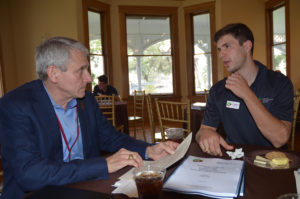Texas A&M future entrepreneurs lay foundation for potential businesses
Agricultural economics seniors hone business skills in capstone program
Writer: Blair Fannin, 979-845-2259, [email protected]
Contact: Dr. Ed Rister, 979-255-5211, [email protected]
COLLEGE STATION – Venturing into a business of your own can be a daunting task, but 36 agricultural economics students at Texas A&M University are well on their way to entering the world of entrepreneurship.
The Agricultural Economics 425 seniors recently spent a full day as part of the Donald G. “Don” Kaspar ‘49 Agribusiness Entrepreneurship Mentoring Forum, meeting one-on-one with business professionals who would hone their business plans.
The business professionals are mentors who represent a broad range of professional expertise from banking, investments, agriculture and management.
All of the preparation is prior to writing and producing their final business plan project later this May. The work is part of a two-semester commitment for the students and the course has an Agricultural Economics 424 prerequisite.

From the start, students understand the course is not one to take lightly, said Dr. Ed Rister, department of agricultural economics professor in the College of Agriculture and Life Sciences and a Texas A&M AgriLife Research economist.
“It starts tough and just gets tougher,” Rister said. “We call the students who make it to the end, ‘the survivors,’” he said.
One of the mentors, Murray Edwards said he discovered early on as a student at Texas A&M he wanted to go out on his own.
“I worked a summer job while attending Texas A&M and later found out I didn’t want to work for anyone,” Edwards said. “I read all of the time, I read a lot of history and a lot of biographies.”
“First, for those who have been out of the industry for five or so years, it’s a way for those us who to share wisdom to the students,” said Kelley Sullivan, co-owner of Santa Rosa ranches in Navasota and Crockett. “We want them to be successful and we want to provide them with any guidance and pitfalls we can provide them. That’s what is unique about this program and it reinforces A&M’s tradition of that entrepreneurial, can-do spirit.”
George Nelson, a mentor who spent 41 years in the banking industry in the Bryan-College Station area, said evaluating a business’s risks and opportunities are important for entrepreneurs.
“It’s about the evaluation process and it’s about doing it correctly,” he said. “All of this will help you run a better business. All of this will help you learn why businesses do some of the things they do. It’s not simply being an entrepreneur. Risk evaluation keeps you from running into the wall.”
“We meet a lot of quality students that the bank certainly would want to hire,” said Mark Humphrey of Prosperity Bank in Bryan. “The program Dr. Rister puts on is unique, real-world experience that gives students a clear vision of what it’s like to be an entrepreneur.”
Katie Erwin is one of the course students and has put many long hours into her stocker cattle project idea, which came about from her family’s Oklahoma cattle operation. She meets each Friday with Rister from 5:30-7:30 a.m. to go over her project throughout the semester.
“I think a branded, all-natural beef line has a lot of appeal to consumers who are conscious about all-natural health,” she said. “If they are willing to pay a premium for this line of product, then why not go for it with this business?”
Camilia Prudencio has aspirations of starting her own beauty line using natural oils from her home country in Bolivia. Her Blue Babassu beauty line uses natural oil from coconuts. She plans to market her products through Facebook and Instagram.
Grant Winkelmann created a business plan project for a cut flower farm.
“My main marketing avenue is H-E-B,” he said. “I’m starting out with 2 acres and using five high tunnels. I want to start out small and eventually grow.”
Bill Toler, chairman of the Texas A&M Foundation, served as one of Winklemann’s mentors. He advised him on several points, including price elasticity and consumption habits of consumers per checkout items.
“Out of 100 H-E-B transactions, how many are flowers?” Toler said. “When you think about availability of product (to the large retailers), part of the distribution strategy is targeting them with enough product.”
The students will present their business projects with posters at the May 2-3 Corrigan-Goddard Foundation Entrepreneurial Dreams Symposium at Texas A&M in College Station.


